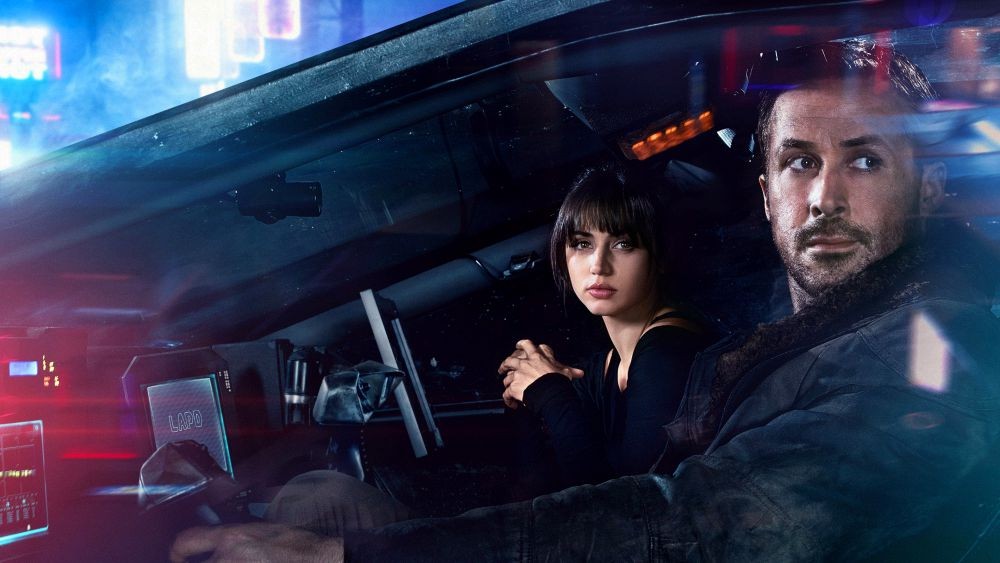Blade Runner 2049
Blade Runner 2049 (2-D version), 2017, 4 ¼ stars
Smart, stunning sci-fi
Blade Runner 2049 is better than the original
From The Orlando Weekly, October 4, 2017
In the original Ridley Scott film, a “blade runner” used a complicated, question-based test to determine whether someone was a human or a lifelike imitation (a replicant). With the arrival of the movie sequel, I propose an easier test: If you don’t value the artistry of Blade Runner 2049, you might not be human.
Whether you fully appreciate the new film’s story is another matter, however, and might depend on your familiarity with the iconic 1982 film. In that movie, Harrison Ford was a police officer charged with hunting down escaped replicants and “retiring” them, until a confrontation with four particularly advanced cyborgs made him question the meaning of his job and even his own identity. (For the last 35 years, moviegoers have fiercely debated whether Ford’s character himself is a replicant.)
Ford reprises his role as Deckard in the new film, which, like its predecessor, is set in a dark, dystopian, rain-drenched Los Angeles. But Ryan Gosling is the star this time. It’s 30 years later, and “K” (Gosling) finds himself in a position even more challenging than Deckard did back in that quaint year of 2019. He is tasked by his boss (Robin Wright) with solving a problem that could lead to the complete breakdown of the societal boundaries between humans and replicants. If he fails, the future of humanity could be at stake.
That might sound like an over-the-top scenario, but it isn’t. In fact, it’s just the type of plot that critics of the original film longed for. Though that original posited profound ideas and offered visual style out the wazoo, some saw it as short on story. Conversely, mostly thanks to its runtime of 163 minutes, today’s critics might contend that this sequel has too much story. But under the careful direction of Denis Villeneuve and inspired storytelling of screenwriters Hampton Fancher and Michael Green, the new film is smart and stunning visually, thematically and emotionally. And though diehard fans of the Scott original might view the following statement as blasphemous, it’s almost as if the 1982 film now exists primarily to set up its sequel.
In a rare move, Villeneuve has asked critics to not discuss the plot or the characters of Blade Runner 2049 in detail. Studio reps at press screenings even read a statement straight from the director, asking reviewers to respect moviegoers’ rights to explore the twists and turns for themselves, without knowing any of the secrets (or cameo performances) in advance. That kind of request usually reeks of pretentious overconfidence, but after Incendies, Prisoners, Sicario and, most significantly, Arrival, Villeneuve has earned the right to make such a request. And with Blade Runner 2049, which easily ranks among the top five films of the year so far and the best sci-fi film since Christopher Nolan’s Interstellar in 2014, Villeneuve has also earned a galaxy of cinematic respect.
Gosling delivers an assured and pitch-perfect performance while Ford is, well, Ford. Supporting performances range from competent to stunning, though Jared Leto’s brief turn (as the Godlike head of the company that took over the manufacture of replicants when the Tyrell Corporation folded) isn’t altogether successful. (The biblical themes are even more evident here than in the original film.) But the real stars are the eye-popping special effects (which, though reliant on CGI, resemble the practical effects of the original) and the cinematography from veteran Roger Deakins. After being a bridesmaid through 13 Oscar nominations, perhaps this is finally Deakins’ time to take the trophy, although he’ll have to beat out Hoyte Van Hoytema, who shot this year’s best film, Dunkirk.
Though the new film retains much of the original’s chiaroscuro and slow pacing, it’s a tad brighter – if not in theme, then in visual design. Referencing the literal darkness of the original in a metatheatrical moment, one character in the new film exclaims, “Too dark in here,” before flipping a switch to illuminate a room shrouded in shadow. That’s something that never would have happened in the 1982 film, and it does mean that the new film lacks some of the original’s claustrophobia. But Villeneuve’s film is easier to understand, both visually and metaphorically.
Philip K. Dick’s 1968 novel, Do Androids Dream of Electric Sheep?, inspired Blade Runner and, like fellow ‘60s fare 2001: A Space Odyssey and The Twilight Zone episode “In His Image,” explored the ideas of artificial intelligence and implanted memories. This sequel actually does a better job of mining those rich ideas than the original, as it puts you inside the mind of a man, who, like Pinocchio, ponders what it means to be real.
“To be born is to have a soul, I guess,” a replicant conjectures. “You’ve been getting on fine without one,” a human assures him.
© 2017 Orlando Weekly / MeierMovies, LLC
